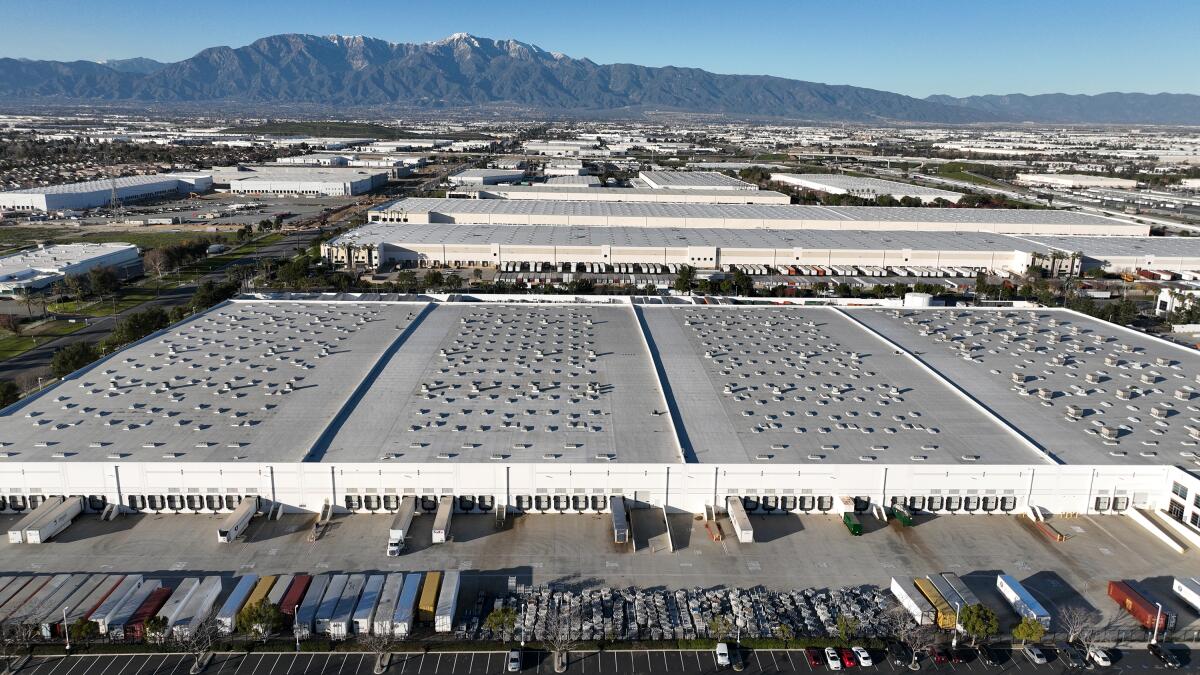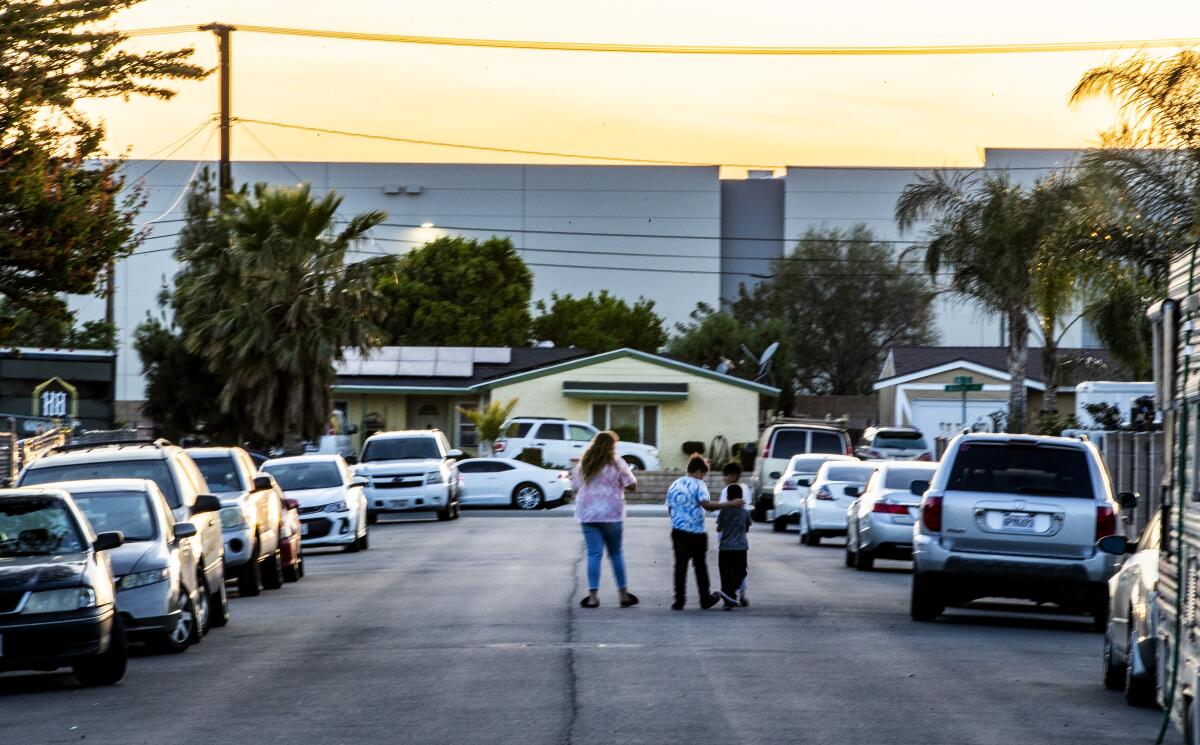Inland Empire residents are fighting warehouse sprawl

Good morning, and welcome to the Essential California newsletter. It’s Tuesday, Feb. 7.
E-commerce has created a world where we can order something with a few quick taps on our phones, then find it on the doormat within days (or even hours).
For a growing number of consumers, there’s a decent chance the contents of their packages came from a warehouse in the Inland Empire.
The region, which includes large swaths of communities in Riverside and San Bernardino counties, has become the dominion of thousands of massive warehouses, storing millions of consumer goods trucked in from coastal ports and bound for front doors and mailboxes across California and the nation.
According to one research group’s mapping data, warehouses cover more than 1.5 billion square feet of land there (including parking lots). An additional 170 million square feet of warehouses are planned or under construction, enough to cover the city of West Hollywood about three times over.
The resulting impacts have many residents, farmers and environmental advocates worried.
Rachel Uranga covers transportation and mobility for The Times and reported on the changing landscape in the Inland Empire. She writes:
Residents are questioning whether they want the region’s economy, health, traffic and general ambiance tied to a heavily polluting, low-wage industry that might one day pick up and leave as global trade routes shift.
Rachel told me the issue is the “perfect intersection” of business, consumer culture and transportation issues.
“E-commerce is really reshaping parts of Southern California,” she told me. “For a lot of people, it’s out of their sight — the only way they see it is the little Amazon truck comes up and delivers your packet and leaves ... but it’s so deeply changed [the IE].”
Moving thousands of warehouses’ worth of product relies on big, diesel-burning trucks, which clog and crack local streets and freeways. They also contribute to the region’s terrible, harmful air quality.
The IE now holds the crown for smoggiest place in the U.S., according to the American Lung Assn. The constant stream of trucks rolling to and from all those warehouses “spew out a cocktail of pollutants, including particulates that lodge in human lungs,” Rachel reports.
Researchers have linked the truck pollution to serious health hazards such as asthma, decreased lung function in children and cancer.
“We know diesel exhaust is a killer,” William Barrett, national senior director of clean air advocacy for the American Lung Assn., told Rachel. “It’s one of the most damaging things that your lungs can experience.”

Residents, advocates and environmental researchers want that to change. A coalition of more than 60 environmental, labor, community and academic groups wrote a letter to Gov. Gavin Newsom, asking him to declare the region’s warehouse sprawl a “public health emergency.” The group also called for a moratorium of up to two years on new warehouse development in the region.
The group has accused local politicians of “environmental racism,” Rachel reports, contending they’ve been “ignoring health impacts while collecting donations from developers and their allies.”
Some cities in and near the Inland Empire have already put a hold on new warehouses. A spokesperson for Newsom did not say whether the governor supported a regional moratorium, but pointed to Newsom’s order that heavy-duty truck manufacturers transition to zero-emission vehicles by 2045.
In the meantime many IE residents continue to live in the shadows of warehouses, breathing harmful pollutants. One resident-turned-activist Rachel spoke with described children waking up “with bloody noses on their pillows.”
“We have the worst air quality. We have gridlock,” the resident said. “We have streets and communities that were never built for global logistics.”
You can read Rachel’s full reporting on the issue here.
We have a new reader callout! With Valentine’s Day approaching, we think now is a great time to share some California love — and we need your help. Send in your cutest, wittiest Valentine card message, centered on some aspect of life in the Golden State. Here are a few examples from me:
- Are you the Santa Ana winds? Because you sweep me off my feet.
- I’ll pick you up from LAX anytime.
- You must be a non-native palm tree because you never throw shade my way.
Now it’s your turn! Submit your ideas here. We could feature your “Calentine” in an upcoming edition of Essential California (please keep submissions under 50 words).
And now, here’s what’s happening across California:
Note: Some of the sites we link to may limit the number of stories you can access without subscribing.
Check out "The Times" podcast for essential news and more
These days, waking up to current events can be, well, daunting. If you’re seeking a more balanced news diet, “The Times” podcast is for you. Gustavo Arellano, along with a diverse set of reporters from the award-winning L.A. Times newsroom, delivers the most interesting stories from the Los Angeles Times every Monday, Wednesday and Friday. Listen and subscribe wherever you get your podcasts.
POLITICS AND GOVERNMENT
Gov. Gavin Newsom is calling for a federal investigation into California’s soaring natural gas bills. He wrote a letter to the Federal Energy Regulatory Commission on Monday, requesting that it help in “assessing whether market manipulation, anticompetitive behavior, or other anomalous activities are driving these ongoing elevated prices in the western gas markets.” The Sacramento Bee
California’s lawmakers have passed bills supporting unionizing efforts in several industries in the state but have so far not extended the same legal support to their own staffers. That could change this session with a new bill introduced by Assemblymember Tina McKinnor (D-Inglewood). CalMatters
San Diego businessman Richard Leib has a new venture: leading the powerful University of California Board of Regents. He says his top priority will be widening access to better reflect California’s racial, ethnic, economic and geographical diversity. Los Angeles Times
CRIME, COURTS AND POLICING
Racial profiling continues to proliferate in law enforcement agencies across California, according to data on stops released last week by the state attorney general. An analysis by the San Francisco Chronicle found that police are far more likely to stop and search Black drivers and pedestrians than white people in nearly every part of the state. Data collected from smaller law enforcement agencies showed the disparity is worse in some of the state’s wealthiest communities. San Francisco Chronicle
Support our journalism
HEALTH AND THE ENVIRONMENT
With thousands dead and rescuers still searching for survivors, the devastation from the 7.8 earthquake that struck Turkey on Monday is difficult to quantify. The news also naturally takes our minds to the quake-prone ground beneath our own feet. Here’s how a similarly intense temblor would affect Southern California. Los Angeles Times
Can bighorns, a bullet train and a huge solar farm coexist in the Mojave Desert? Times reporter Louis Sahagún writes about a pair of proposals that are testing “state Fish and Wildlife’s ability to mediate compromises among the developers while also planning a sustainable future for complex and fragile ecological networks across the desert.” Los Angeles Times
Climate change is straining some often-overlooked amphibians: California’s newts. Researchers say worsening drought has dried out their habitats, threatening their ability to reproduce. KQED
CALIFORNIA CULTURE
L.A.’s Crypto.com Arena hosted the 65th Grammy Awards on Sunday night. From historic firsts to controversial snubs to Viola Davis’ EGOT (Emmy, Grammy, Oscar and Tony) status, here’s a recap of the show and a list of the winners. Los Angeles Times
Free online games
Get our free daily crossword puzzle, sudoku, word search and arcade games in our new game center at latimes.com/games.
AND FINALLY
Today’s landmark love comes from Theo Moreno of Cambria: Arroyo Laguna Beach.
Theo writes:
With over 700 miles of coastline, California offers several places where one can surf without a crowd. Sure, the water’s a little colder, but the trade-off is well worth the chill. This is a favorite spot of mine in San Luis Obispo County. I didn’t know the surfer, but he did get a couple of nice waves.
What are California’s essential landmarks? Fill out this form to send us your photos of a special spot in California — natural or human-made. Tell us why it’s interesting and what makes it a symbol of life in the Golden State. Please be sure to include only photos taken directly by you. Your submission could be featured in a future edition of the newsletter.
Please let us know what we can do to make this newsletter more useful to you. Send comments to essentialcalifornia@latimes.com.
Sign up for Essential California
The most important California stories and recommendations in your inbox every morning.
You may occasionally receive promotional content from the Los Angeles Times.



